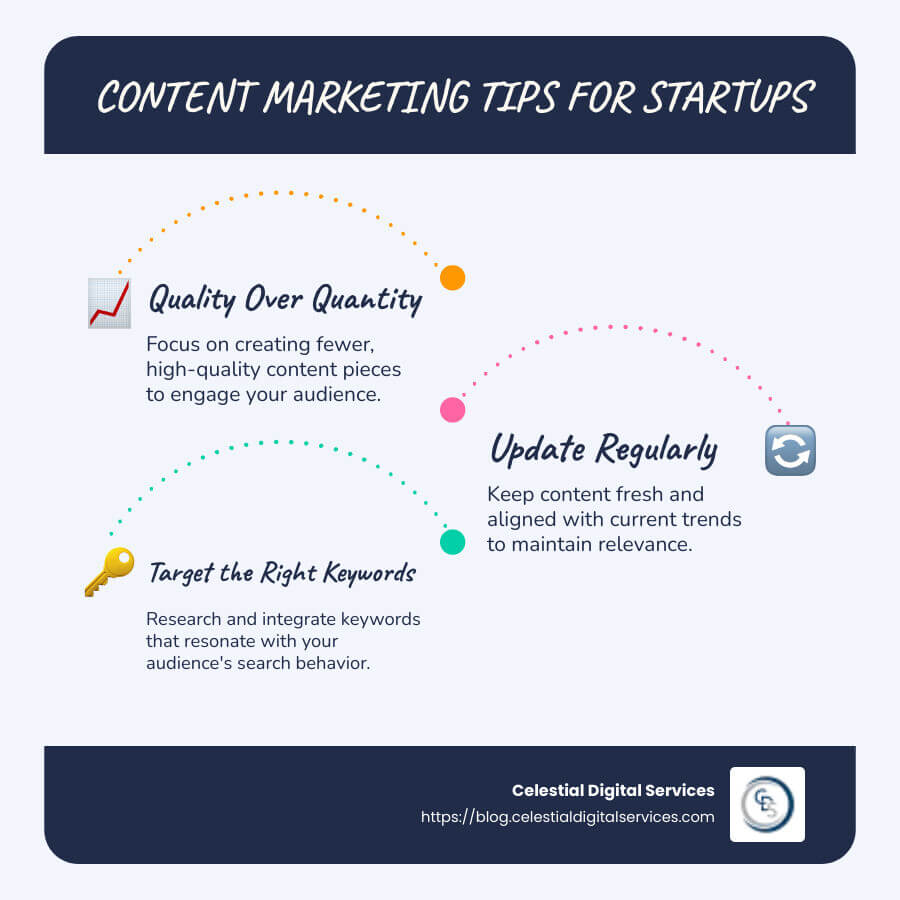Content marketing tips for startups are crucial for achieving business success in today’s digital world. Let’s quickly unpack the essentials:
- Quality Over Quantity: Focus on creating fewer, but higher-quality content pieces.
- Update Regularly: Keep your content fresh and relevant to current trends.
- Target the Right Keywords: Research and incorporate keywords that your audience searches most.
Starting a business means every decision, including content marketing, should be strategic. Content marketing can propel your startup’s growth by establishing authority and engaging your audience effectively. This approach not only builds trust but drives customer loyalty, ultimately converting interactions into sales.
With over a decade of experience in digital marketing, I specialize in SEO/SEM optimization, social media marketing, and lead generation strategies. My expertise is anchored in providing actionable content marketing tips for startups aimed at enhancing your online presence and maximizing growth potential.

Content marketing tips for startups terms you need:
– 10 easy tips for effective content marketing
– content marketing tips for small business owners
– content creation strategy
Understanding Your Target Audience
Before diving into content creation, understanding who you’re talking to is key. This is where buyer personas come in. Think of them as your audience’s avatars. They help you visualize and understand the people you want to reach.
Buyer Personas
Creating buyer personas means crafting detailed profiles of your ideal customers. These profiles include demographics, interests, and pain points. For example, if your startup offers eco-friendly products, your persona might be “Eco-conscious Emma,” a 30-year-old urban professional who values sustainability.
Why is this important? Knowing your audience helps tailor your content to their needs and preferences, increasing engagement and conversion rates.
Audience Insights
Gathering audience insights is about collecting data to understand your audience better. Use tools like Google Analytics to see who visits your site, what they read, and how long they stay. This data is gold. It tells you what content resonates and what doesn’t.
Conducting surveys can also provide direct feedback. Ask your audience what they want to see more of. Their answers will guide your content strategy.
User Interviews
User interviews are a powerful way to gather qualitative data. They offer a deeper understanding of your audience’s motivations and challenges. Consider setting up interviews with a few people from your target audience. Ask open-ended questions like, “What challenges are you facing in your industry?” or “What type of content do you find most helpful?”
These conversations can reveal insights that numbers alone can’t provide. They help you create content that truly speaks to your audience’s needs.
Understanding your target audience is the foundation of effective content marketing. Next, we’ll explore how to map your content to the customer’s journey, ensuring it meets your audience at every stage.
Mapping Content to the Customer’s Journey
Creating content that aligns with your customer’s journey is crucial for driving engagement and conversions. This journey typically consists of three main stages: awareness, consideration, and decision. Each stage requires different types of content to effectively guide your audience.
Awareness Stage
At this point, potential customers realize they have a problem or need. Your goal here is to attract attention and provide valuable information.
Content Types: Blog posts, infographics, and social media updates are perfect. They introduce problems and offer insights without pushing for a sale. For instance, a blog post titled “Top 5 Challenges Small Businesses Face in 2023” can draw in readers who are just starting to explore solutions.
Consideration Stage
Here, your audience is evaluating different options. They’re looking for solutions and comparing your offerings to others.
Content Types: Detailed guides, webinars, and videos work well. They provide in-depth information and showcase your expertise. A SaaS startup might offer a webinar on “How Our Software Simplifies Business Operations,” helping potential customers understand the benefits of their solution.
Decision Stage
At this final stage, prospects are ready to make a purchase decision. Your content should reassure them and drive them to choose you.
Content Types: Case studies, testimonials, and product demos are key. They highlight real-world success and build trust. A compelling case study showing how your product increased a client’s efficiency by 50% can be the tipping point for decision-makers.
Content Mapping
Mapping content to these stages ensures you meet your audience where they are. Use a simple table to plan this:
| Customer Stage | Content Goal | Content Type |
|---|---|---|
| Awareness | Educate and attract | Blog posts, Infographics |
| Consideration | Inform and engage | Guides, Webinars |
| Decision | Convert and reassure | Case Studies, Demos |
This strategy not only guides potential customers through their journey but also boosts engagement at each stage.

Understanding and mapping the customer journey is essential for effective content marketing. By doing so, you ensure your content resonates with your audience, increasing engagement and conversion rates. Next, we’ll explore how to create content that adds real value to your audience’s experience.
Creating Valuable Content
Creating content that truly resonates with your audience is key for any startup looking to grow. It’s not just about churning out material; it’s about crafting quality content that meets your audience’s needs and stands out in the crowded digital space.
Quality Content
Quality over quantity is essential. It’s better to produce fewer pieces that are rich and insightful than to flood your channels with mediocre content. High-quality content builds trust, improves credibility, and provides long-term SEO benefits. For instance, well-researched articles often garner more shares, backlinks, and sustained engagement.
- Research Extensively: Go beyond surface-level information. Dive deep into data and provide comprehensive insights that answer your audience’s questions.
- Refine and Edit: Proofread carefully to eliminate grammatical errors and improve clarity. This step ensures your content is polished and professional.
- Include Expert Opinions: Citing specialists and using statistics can lift the credibility of your content.

Content Types
Different content types serve different purposes. Knowing which to use and when can significantly impact your strategy.
- Blog Posts: The backbone of inbound marketing. They are versatile and can drive organic traffic while establishing your expertise.
- Videos: Engaging and versatile, videos can convey complex information quickly. They are perfect for tutorials, product demos, or testimonials.
- Infographics: These are ideal for presenting data in a visually appealing way. They are easy to share and can simplify complex information.
- Case Studies: Showcase real-world applications of your products or services. They build credibility and attract potential customers by highlighting success stories.
Content Creation
Creating content that resonates involves more than just writing. It’s about delivering value and aligning with your audience’s needs.
- Identify Pain Points: Listen to your audience and address their challenges. This ensures your content is relevant and valuable.
- Offer Unique Insights: Go beyond the basics and provide perspectives that aren’t readily available elsewhere. This sets you apart as an authority.
- Structure Matters: Use clear headings, bullet points, and visuals to make your content digestible. This improves readability and keeps your audience engaged.
By focusing on these elements, startups can create content that not only captures attention but also delivers real value. This approach not only improves your brand’s reputation but also aids in turning site visitors into loyal customers.
Next, we’ll dive into how to effectively promote your content to reach a broader audience and maximize your impact.
Promoting Your Content
Creating great content is just the beginning. The next step is to ensure that it reaches the right audience. A well-crafted distribution strategy is crucial for amplifying your message and driving engagement. Let’s explore how you can effectively promote your content using social media and other promotion channels.
Distribution Strategy
A successful distribution strategy involves planning where and how your content will be shared. This ensures that your hard work doesn’t go unnoticed. Here are some key elements to consider:
- Identify Your Channels: Focus on platforms where your audience spends most of their time. This could include social media, email newsletters, or industry-specific forums.
- Leverage Partnerships: Collaborate with influencers or other businesses to expand your reach. Their endorsement can introduce your content to a wider audience.
- Repurpose Content: Adapt your content for different formats and platforms. A blog post can become a series of social media posts, an infographic, or even a podcast episode.
Social Media
Social media is a powerful tool for startups. It allows you to engage directly with your audience and amplify your reach. Here’s how to make the most of it:
- Engage with Your Audience: Use polls, Q&A sessions, and interactive posts to foster engagement. This not only boosts visibility but also builds a community around your brand.
- Consistent Posting Schedule: Regular updates keep your audience engaged and informed. Use a content calendar to plan and schedule posts in advance.
- Visual Content: Eye-catching images and videos are more likely to capture attention. Incorporate these into your social media strategy to increase shares and interactions.
Promotion Channels
Beyond social media, there are various channels to consider for promoting your content:
- Email Marketing: Send newsletters to your subscribers featuring your latest content. Personalize these emails to increase open rates and engagement.
- SEO Optimization: Ensure your content is optimized for search engines. This increases its visibility and attracts organic traffic.
- Guest Posting: Write articles for other websites or blogs in your industry. This not only builds backlinks but also positions you as an expert in your field.
By implementing these strategies, you can ensure that your content doesn’t just sit idle. Instead, it will actively work to attract, engage, and convert your audience.
Next, we’ll look at how to measure the success of your content marketing efforts and make data-driven decisions to refine your strategy.
Measuring Success in Content Marketing
Once your content is out in the world, the real work begins. How do you know if it’s making an impact? This is where measuring success becomes crucial. By focusing on Key Performance Indicators (KPIs), using analytics tools, and making data-driven decisions, you can refine your strategy to propel your startup’s growth.
Key Performance Indicators (KPIs)
KPIs are your best friends when it comes to measuring success. They tell you if your content is hitting the mark. Here are a few KPIs to keep an eye on:
- Unique Page Views: This shows how many different people are looking at your content. It’s a good measure of reach.
- Engagement Rate: Includes likes, shares, and comments. High engagement means your content resonates with your audience.
- Conversion Rate: The percentage of visitors who take a desired action, like signing up for a newsletter. This is crucial for measuring the effectiveness of your content in driving business goals.
Analytics Tools
To track these KPIs effectively, you’ll need the right tools. Google Analytics is a popular choice for startups. It provides detailed insights into traffic sources, user behavior, and more. Here’s how to make the most out of analytics tools:
- Traffic Sources: Find where your audience is coming from. Are they finding you through social media, search engines, or direct visits?
- Bounce Rate: A high bounce rate means visitors leave your site quickly, indicating that your content might not be meeting their expectations.
- Time on Page: This tells you how long users spend on a page. Longer times suggest more engaging content.
Data-Driven Decisions
Making decisions based on data is a game-changer. It allows you to tweak your strategy based on what’s working and what’s not. Here’s how to approach it:
- A/B Testing: Experiment with different headlines, images, or calls to action to see what resonates best with your audience.
- Iterate and Improve: Use the data you gather to refine your content. If a blog post drives traffic but doesn’t convert, consider revisiting the call-to-action.
- Regular Reviews: Schedule monthly or quarterly reviews of your content’s performance. This helps ensure your strategy remains aligned with your business objectives.

By focusing on these metrics and tools, you can ensure your content marketing strategy is not just effective, but continuously improving. Up next, we’ll address some frequently asked questions about content marketing tips for startups.
Frequently Asked Questions about Content Marketing Tips for Startups
What are the 5 pillars of content strategy?
To build a strong content strategy, focus on these five pillars:
-
Goals: Start with clear goals. Are you looking to increase brand awareness or drive sales? Setting SMART (Specific, Measurable, Achievable, Relevant, Time-bound) goals can guide your content efforts.
-
Audience: Know your audience inside out. Create detailed buyer personas to understand their needs, preferences, and challenges. This ensures your content is relevant and engaging.
-
Audit: Conduct a content audit to evaluate what’s working and what’s not. This involves reviewing your existing content to identify gaps and opportunities for improvement.
-
Content Types: Decide on the types of content that best suit your audience and goals. This can include blog posts, videos, infographics, and more.
-
Content Plan: Develop a content plan that outlines what you will create, when, and where it will be published. A well-structured plan ensures consistency and alignment with your goals.
How should I get started with content marketing?
Getting started with content marketing involves several key steps:
-
Goals: Begin by defining your content marketing goals. What do you want to achieve? This will shape your entire strategy.
-
Audience: Identify your target audience. Conduct user interviews and gather insights to create content that resonates with them.
-
Audit: Perform an audit of your current content. Understand what has worked in the past and where there are gaps.
-
Themes: Choose overarching themes that align with your brand and audience interests. This will help in creating cohesive and focused content.
-
Funnel: Map your content to different stages of the marketing funnel. Create content that guides your audience from awareness to consideration and finally to conversion.
What are the 7 steps in creating a content strategy?
Creating a content strategy involves these seven steps:
-
Audience: Understand who your audience is and what they care about. This will inform every piece of content you create.
-
Goals: Clearly define your goals. Know what success looks like for your content marketing efforts.
-
Content Type: Decide on the most effective content types for your audience. Consider factors like engagement and the platforms they use.
-
Topics: Choose topics that align with your audience’s interests and your business objectives. This ensures your content is relevant and valuable.
-
Calendar: Develop a content calendar to schedule your posts. This helps maintain consistency and ensures regular engagement with your audience.
-
Quality: Focus on creating high-quality content. This builds trust and positions your brand as an authority in your industry.
-
Promotion: Plan how you will promote your content. Use social media, email marketing, and other channels to reach your audience effectively.
These steps provide a roadmap for creating a content strategy that can propel your startup’s growth. Up next, we’ll explore more about how Celestial Digital Services can support your digital marketing needs.
Conclusion
In today’s digital world, having a strong online presence is crucial for startups. At Celestial Digital Services, we understand the unique challenges startups face and are committed to providing innovative digital solutions to help you thrive.
Why Choose Us?
We specialize in empowering small businesses with custom strategies that improve their visibility and engagement online. Our range of services includes SEO, social media marketing, and AI-based tools, all designed to simplify digital marketing for those less familiar with the technical aspects. Our goal is to make your digital journey smooth and effective, ensuring you can focus on what you do best—running your business.
Our Approach
We believe in a personalized approach. Every startup is unique, and so are its needs. By understanding your specific goals and audience, we craft strategies that are not only effective but also aligned with your business objectives. Our team stays ahead of industry trends to provide cutting-edge solutions that deliver results.
Ready to Propel Your Growth?
If you’re looking to boost your online presence and achieve remarkable growth, let us be your trusted partner. Our expertise in content marketing and digital solutions can help you steer the competitive online landscape with confidence.
Explore our services and find how Celestial Digital Services can propel your startup’s growth. Together, we can achieve success in the digital age.



